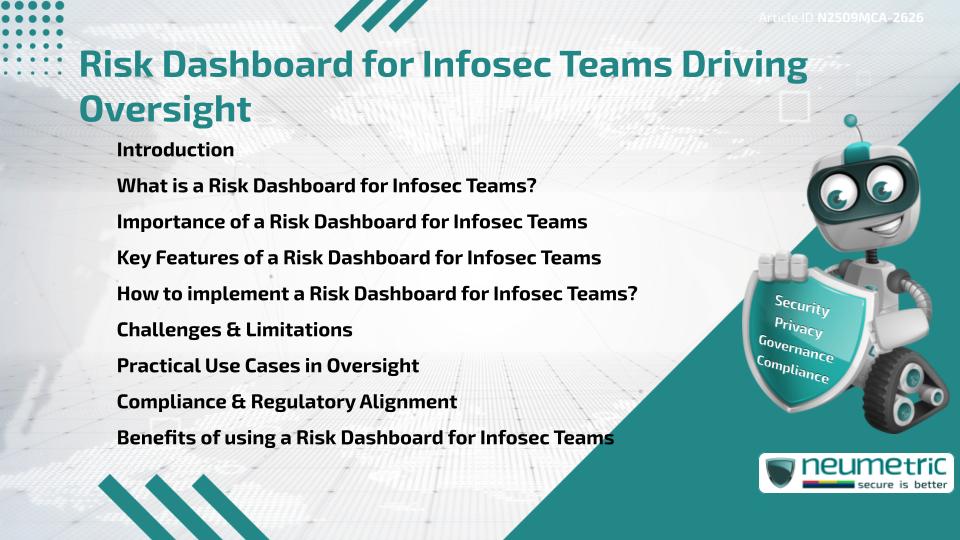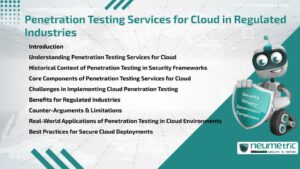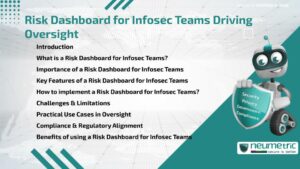Table of Contents
ToggleIntroduction
A Risk dashboard for InfoSec teams provides a centralized platform to monitor, assess & respond to security Risks in real time. By consolidating data from multiple tools & processes, it improves visibility into Vulnerabilities, compliance gaps & ongoing Security Performance. This article explains what a Risk dashboard for InfoSec teams is, why it matters, its core features & how it can be successfully implemented to drive oversight.
What is a Risk Dashboard for InfoSec Teams?
A Risk dashboard for InfoSec teams is a visual interface that aggregates & displays security Risk information in an easily interpretable format. It integrates data from Threat detection systems, compliance trackers & Incident Response platforms. With this unified view, teams can prioritise Risks, track key performance indicators & make faster decisions.
Importance of a Risk Dashboard for InfoSec Teams
InfoSec teams handle vast amounts of data from intrusion detection systems, firewalls & Endpoint Protection. Without consolidation, critical insights may be missed. A Risk dashboard for InfoSec teams ensures that decision-makers can identify trends, respond to Threats promptly & allocate resources effectively. It also enhances transparency, enabling executives & Auditors to understand the organisation’s security posture.
Key Features of a Risk Dashboard for Infosec Teams
An effective dashboard typically includes:
- Real-time monitoring: continuous updates on Threats & Vulnerabilities.
- Risk scoring: numerical values assigned to Risks for prioritisation.
- Compliance tracking: alignment with frameworks such as GDPR, HIPAA & ISO 27001.
- Incident reporting: visualization of ongoing & resolved incidents.
- Customizable metrics: flexibility to match organisational objectives.
- Integration capabilities: compatibility with existing tools like SIEM & Vulnerability scanners.
How to implement a Risk Dashboard for Infosec Teams?
Implementing a dashboard involves several steps:
- Define objectives: clarify oversight goals & Compliance Requirements.
- Select tools: choose a platform that integrates with existing systems.
- Collect data: ensure accurate feeds from multiple sources.
- Design visualization: create clear & actionable metrics.
- Train users: provide InfoSec teams with training on interpreting dashboards.
- Review & update: regularly refine metrics to reflect evolving Risks.
Challenges & Limitations
Despite its benefits, deploying a Risk dashboard for infosec teams presents challenges. Data overload can lead to misinterpretation if dashboards are not well designed. Some Organisations may lack integration between legacy tools & modern dashboards. Additionally, dashboards require continuous updates to remain relevant to emerging Threats.
Practical Use Cases in Oversight
For example, an infosec team may use a dashboard to track phishing attack trends across departments, ensuring targeted awareness training. Another use case is monitoring patch compliance across endpoints to quickly identify & remediate unpatched systems. Dashboards can also highlight deviations from regulatory requirements, supporting Audit readiness.
Compliance & Regulatory Alignment
Compliance frameworks increasingly emphasize Transparency & Accountability in Risk Management. A Risk dashboard for infosec teams supports these requirements by documenting Risk levels, control effectiveness & incident responses. Resources such as the NIST Cybersecurity Framework, ISO/IEC 27001 & HIPAA Security Rule provide guidance on aligning dashboards with regulatory expectations.
Benefits of using a Risk Dashboard for Infosec Teams
Using a dashboard brings multiple advantages:
- Enhanced oversight through real-time insights.
- Improved prioritisation of critical Threats.
- Stronger compliance posture.
- Faster Incident Response & remediation.
- Increased communication between infosec teams & executives.
Takeaways
- A Risk dashboard for infosec teams consolidates security data into actionable insights.
- It improves oversight, compliance & Incident Response.
- Core features include Risk scoring, compliance tracking & integration.
- Dashboards support both operational needs & strategic decision-making.
FAQ
What is the purpose of a Risk dashboard for InfoSec teams?
Its purpose is to provide centralized oversight of Risks, compliance gaps & Security Performance.
How does a Risk dashboard for InfoSec teams improve oversight?
By consolidating data from multiple systems, it highlights trends & enables faster responses to Threats.
What compliance frameworks can a Risk dashboard support?
Frameworks such as GDPR, HIPAA, ISO 27001 & NIST can be tracked through dashboards.
Do Risk dashboards replace other security tools?
No, they complement existing tools by consolidating data into a unified view.
How often should a Risk dashboard for InfoSec teams be updated?
Dashboards should update in real time or near real time to reflect current Risks.
What are common challenges in implementing dashboards?
Challenges include data overload, poor integration with legacy systems & lack of skilled staff for analysis.
Can dashboards be customized for different Organisations?
Yes, dashboards can be tailored with specific metrics, visuals & integrations to match organisational needs.
Need help for Security, Privacy, Governance & VAPT?
Neumetric provides organisations the necessary help to achieve their Cybersecurity, Compliance, Governance, Privacy, Certifications & Pentesting needs.
Organisations & Businesses, specifically those which provide SaaS & AI Solutions in the Fintech, BFSI & other regulated sectors, usually need a Cybersecurity Partner for meeting & maintaining the ongoing Security & Privacy needs & requirements of their Enterprise Clients & Privacy conscious Customers.
SOC 2, ISO 27001, ISO 42001, NIST, HIPAA, HECVAT, EU GDPR are some of the Frameworks that are served by Fusion – a SaaS, multimodular, multitenant, centralised, automated, Cybersecurity & Compliance Management system.
Neumetric also provides Expert Services for technical security which covers VAPT for Web Applications, APIs, iOS & Android Mobile Apps, Security Testing for AWS & other Cloud Environments & Cloud Infrastructure & other similar scopes.
Reach out to us by Email or filling out the Contact Form…





